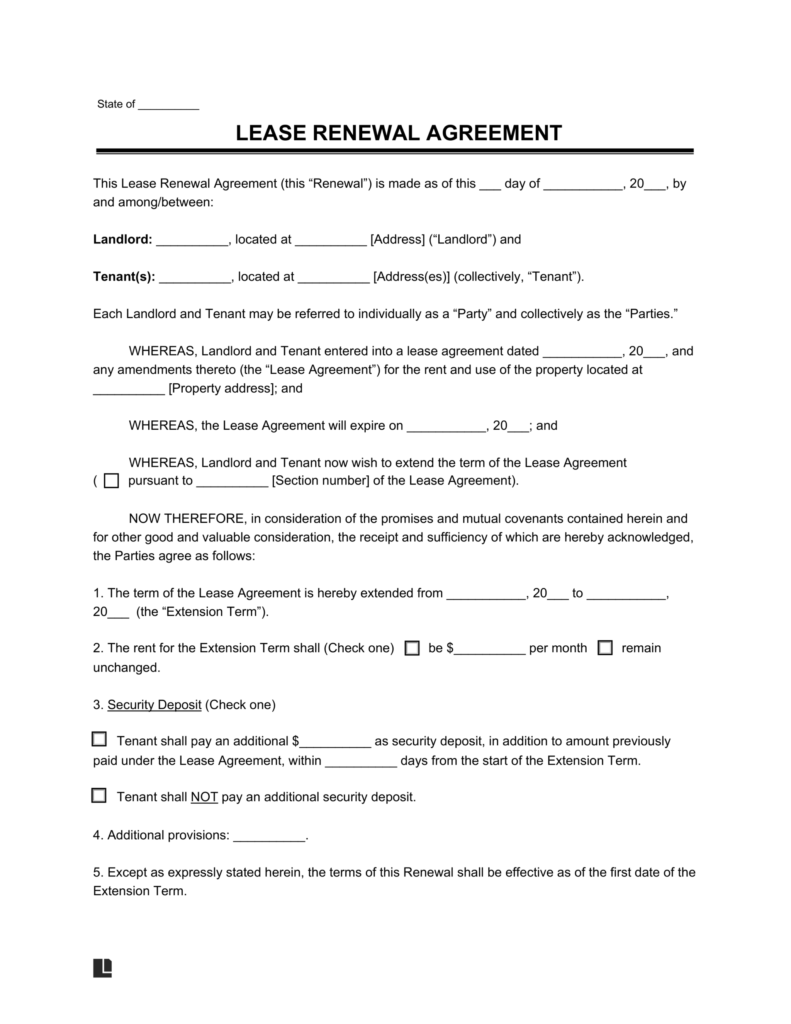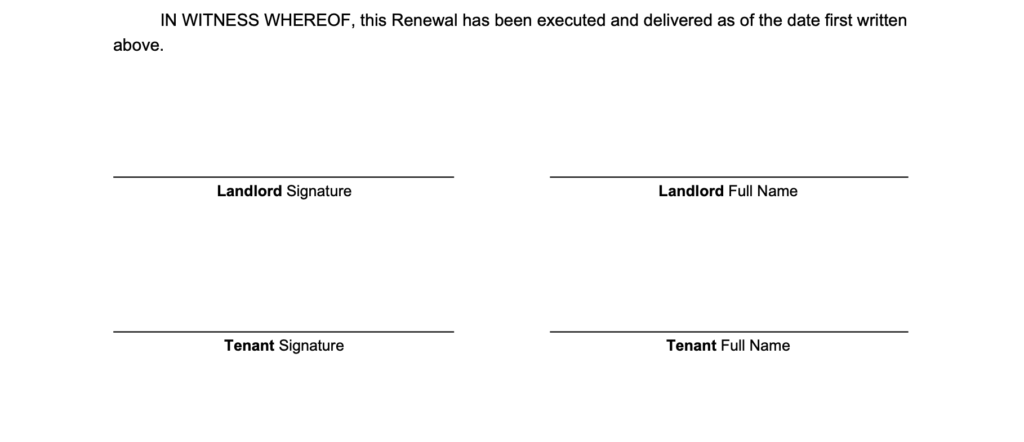Georgia Lease Renewal Agreement Template
Utilize our Lease Renewal Agreement to prolong the duration of an existing lease.
Select your state below to find a Lease Renewal Agreement Template
A Lease Renewal Agreement is a document that allows a landlord to extend the current rental period with a tenant.
- Lease Renewal Agreement: An Overview
- Lease Renewal vs. Lease Extension: Unveiling the Differences
- Lease Renewal Agreement Example
- When to Use a Lease Renewal Agreement
- How to Effectively Use a Lease Renewal Agreement
- How to Write (Fill) a Lease Renewal Agreement
- Frequently Asked Questions
- What are the Pros and Cons of Lease Renewals?
- How can I initiate the use of a Lease Renewal Agreement?
- What is the typical notice period for Lease Renewals?
- Lease Renewal Agreement Sample
Lease Renewal Agreement: An Overview
A Lease Renewal Agreement serves as a crucial document in the landlord-tenant relationship, providing a formal mechanism to extend the existing rental period. This legal form acts as an amendment to the original lease agreement, altering its expiration date while retaining the fundamental terms established initially.
Lease Renewal vs. Lease Extension: Unveiling the Differences
While both serve to continue a rental contract, lease renewals and extensions differ in their nature. A lease renewal is essentially a new contract that updates the duration of the rental period and may introduce new terms. Conversely, a lease extension continues the current terms but extends the agreement beyond the original lease period.
Lease Renewal Terms:
While both serve to continue a rental contract, lease renewals and extensions differ in their nature. A lease renewal is essentially a new contract that updates the duration of the rental period and may introduce new terms. Conversely, a lease extension continues the current terms but extends the agreement beyond the original lease period.
Lease Extension Terms:
On the other hand, a Lease Extension Agreement maintains the same terms as the original lease but on an extended timeline. For instance, if a tenant anticipates a delay in closing on a new home, extending the existing lease for a few months might be a practical alternative to signing a new agreement.
Lease Renewal Agreement Example

When to Use a Lease Renewal Agreement
A Lease Renewal Agreement is aptly employed when landlords or tenants wish to continue the current leasing arrangement or modify the existing lease terms. Whether seeking to communicate intentions, request changes to amenities, or adjust rent rates, this document offers a structured approach for both parties.
Additionally, landlords or tenants can leverage a lease renewal agreement to redefine the structure of an existing lease after it concludes. This is particularly useful when contemplating a switch to a short-term or month-to-month lease agreement, allowing for adjustments without restarting the entire rental application process.
Pros and Cons of Lease Renewals:
Opting for a lease renewal presents opportunities for both landlords and tenants. The ability to amend lease terms, increase rent, or maintain a consistent security deposit are among the advantages. However, it's essential to recognize that a lease renewal commits tenants to the entire lease term, potentially leading to tenant loss if they decline to renew. In such cases, a lease extension might be a more suitable alternative.
How to Effectively Use a Lease Renewal Agreement
Initiating the lease renewal process ahead of the expiration date is crucial. While state and local laws define notice periods, providing intent at least 60 days in advance is generally recommended.
State and local laws often define how far in advance a landlord must provide notice of intent to renew or not renew before the lease expires (see table below).
| State | Advance Notice of Renewal and Non-Renewal (Termination) of Lease | Citation |
| Alabama |
None (yearly/fixed tenancies) 30 days (month to month tenancies) |
Alabama Code § 35-9A-441 |
| Alaska |
None (yearly/fixed tenancies) 30 days (month to month tenancies) |
Alaska Stat. § 34.03.290 |
| Arizona |
None (yearly/fixed tenancies) 30 days (month to month tenancies) |
Arizona Rev. Stat. § 33-1375 |
| Arkansas |
None (yearly/fixed tenancies) 30 days (month to month tenancies) |
Arkansas Code § 18-17-704 |
| California |
60 days (yearly/fixed tenancies where tenant has lived at least one year) 30 days (yearly/fixed tenancies where tenant has lived less than one year) 30 days (month to month tenancies) |
California Civ. Code §§ 1946-1946.1 |
Step 1: Send a Lease Renewal Letter
Landlords typically initiate the process by notifying tenants of their willingness to negotiate a renewal or extension. Tenants can also request these conditions, and if they choose not to renew, they should communicate their intent through written notice.
Step 2: Negotiate the Terms
Negotiations primarily rest with the landlord, but tenants can propose amendments. Once both parties agree, the terms are incorporated into the lease renewal agreement. If no changes occur, the agreement should state that the original lease remains unchanged.
Step 3: Gather Important Documents
While a lease renewal usually doesn't necessitate additional legal documents, it's prudent to compile crucial information, including the original lease agreement, the new rent amount, and any changes to terms and conditions.
Step 4: Sign the Lease Renewal Agreement
After agreement on the new terms, both parties sign the lease renewal agreement. It's imperative that everyone involved comprehends the new arrangement, and a copy of the renewed lease agreement should be retained by all parties.
How to Write (Fill) a Lease Renewal Agreement
A lease renewal agreement is essentially the>new, so following the correct steps to complete the form is essential.
Before you fill out your lease renewal agreement, note the state you are contracting in.

Step 1 – Enter the Date of the Agreement
1. Date of Agreement. Provide the date of the lease renewal agreement.

Step 2 – Write Landlord and Tenant Information
2. Landlord Information. Enter the full landlord’s name and address. Note that this is not the address of the leased property.
3. Tenant Information. Enter the name and address of each tenant.

Step 3 – Fill in the Original Lease Details
4. Date of Original Lease Agreement. Write the date of the original lease agreement (in most cases, the date the landlord and tenant signed the original contract).
5. End Date of Original Lease Agreement. Provide the lease term’s end (expiration) date under the original lease agreement.
6. Section Number of Original Lease Agreement. This is optional. You can specify a section or paragraph number in the original lease agreement allowing the lease term extension.

Step 4 – Identify New Lease Term Specifics
7. Start and End Dates. Write the start and end date of the new extended lease term.
8. Rent. State whether the rent for the new lease term changes or remains the same. If it changes, specify the new monthly rent.
9. Security Deposit. Choose whether or not there is any additional security deposit for the new lease term. If yes, state the amount of the other security deposit and when the amount is due by providing the number of days due from the start of the lease term.
10. Additional Provisions. This is optional. You can include any new provisions or modifications to existing terms in the original lease agreement.

Step 5 – Choose Governing Law
11. Governing State Law. Our templates allow the state whose laws will govern the agreement to be pre-filled with your state of residence.

Step 6 – Obtain Signatures
12. Landlord. The landlord provides a signature here as well as a full name.
13. Tenant(s). All tenants provide their signatures here, as well as their full names.

In conclusion, navigating the intricacies of a Lease Renewal Agreement demands a strategic and well-informed approach. By understanding the nuances and following best practices, both landlords and tenants can ensure a seamless continuation of their leasing relationship.
Frequently Asked Questions
What are the Pros and Cons of Lease Renewals?
Pros include the opportunity to amend lease terms, increase rent, or maintain a consistent security deposit. However, the cons involve the commitment of tenants to the entire lease term, which might result in tenant loss if they decline to renew. In such cases, a lease extension might be more suitable.
How can I initiate the use of a Lease Renewal Agreement?
Begin the process by sending a Lease Renewal Letter before the lease ends. State your intent to negotiate a renewal or extension, inquire about the tenant's interest in continuing, or specify that the lease will end as scheduled if no extension occurs.
What is the typical notice period for Lease Renewals?
State and local laws often define notice periods, but a best practice is to provide intent at least 60 days before the lease end date. However, adhere to specific notice requirements based on the applicable laws in your jurisdiction.
Lease Renewal Agreement Sample
Page 1 of
- Parking Space Lease Agreement : Use our Parking Space Lease Agreement to rent a single parking space or spaces in a parking lot.
- Lease Termination Letter : Utilize our template for a lease termination letter to conclude a lease agreement.
- Simple (1-Page) Lease Agreement : Utilize Our Simple (1-Page) Lease Agreement.